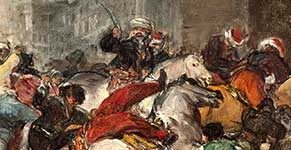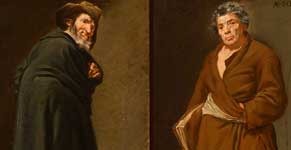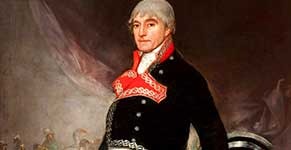Goya’s painting
The chronology of Goya’s paintings, ranging from his youth in Zaragoza to the 1810s, his final period in Madrid, make this one of the top museums for learning about the work of the painter from Fuendetodos.
His youth (1762-1774) in Zaragoza, when he defined his peculiar style, influenced by his first teacher José Luzán, is represented by three paintings. The first is the sketch that Goya did in late 1771 and early 1772 to decorate the fresco on the dome of the Small Choir of the Virgin in the Basilica of Our Lady of the Pillar of Zaragoza, called The Glory or Adoration of the Name of God. In the set of paintings adorning the chapel of the Palace of the Dukes in Sobradiel, two paintings representing Saint Joachim and Saint Anne were rendered in oil on the wall by Goya in 1772.
The museum displays five pieces from his first period in Madrid (1775-1785), three of them religiously-themed sketches or rough drafts and two copies of Velázquez’s Aesop and Menippus that were at the Royal Palace in Madrid. They are deposits of the Real Sociedad Económica Aragonesa de Amigos del País.
Goya’s portrait work is represented very well in the museum, with four major portraits. Self-Portrait of Goya, the first one of the painter known, would have been made around 1775. The second portrait is of Don José de Cistué y Coll, an Aragonese magistrate, which he painted in 1788. Third is the portrait of María Luisa de Parma, the queen consort and wife of Carlos IV, painted between 1789 and 1799. The fourth portrait is of the promiment naturalist and military officer Félix de Azara (1805). A full-body work, it is one of the best portraits to come from Goya’s brush due to its mastery and dazzling use of colour.
The Goya Museum – Ibercaja Collection has two romantic paintings from the end of the Peninsular War or immediately thereafter. The sketch of The Second of May 1808, a scene also popularly known as The Charge of the Mamelukes, was made in preparation for Goya’s great painting hanging in the Prado Museum in Madrid. Masked Dance or Masked Dancers Under an Arch, made in 1814-1815, is one of those works that reflected whims that were products of his imagination or his critical view of reality.





